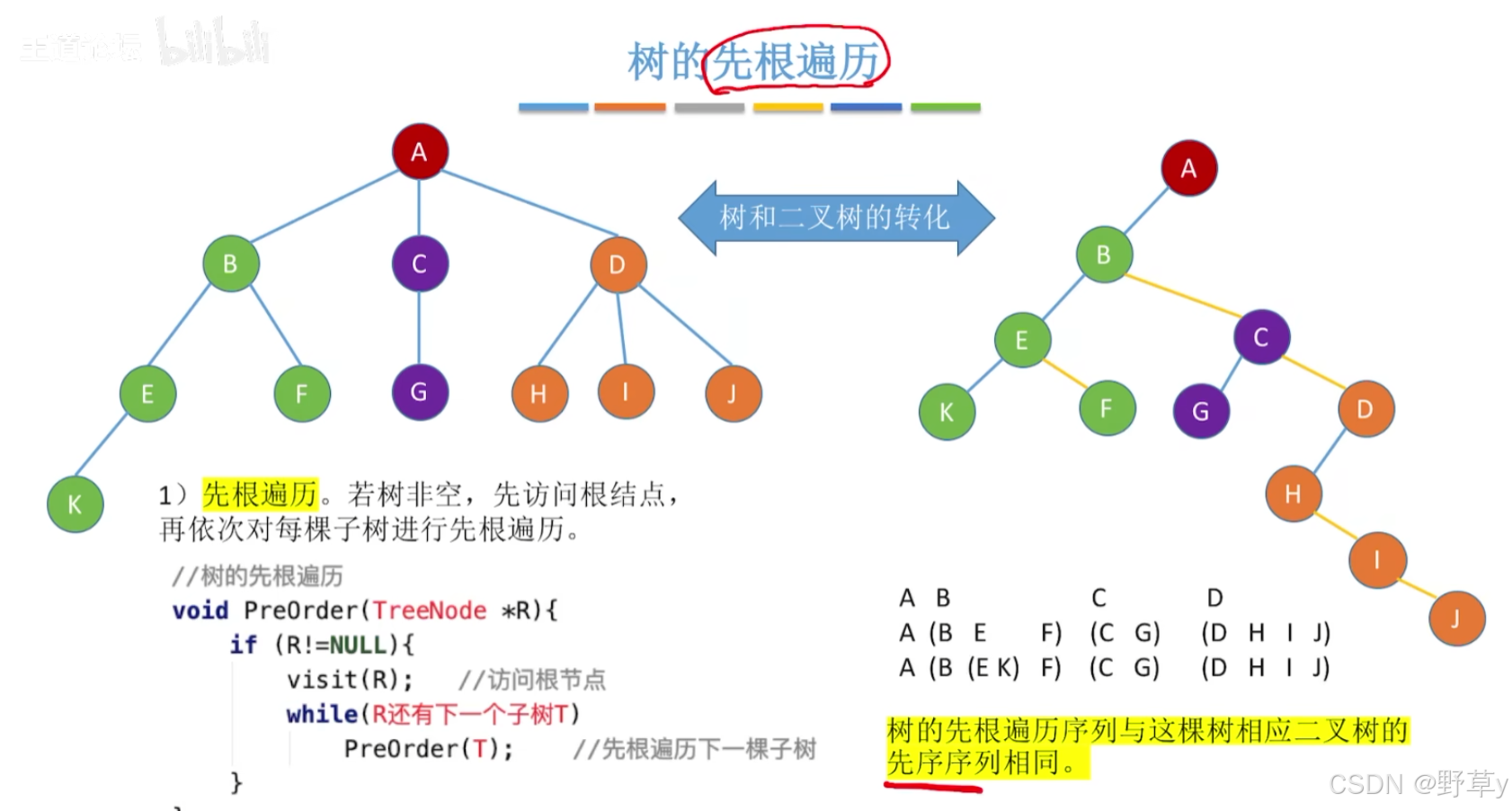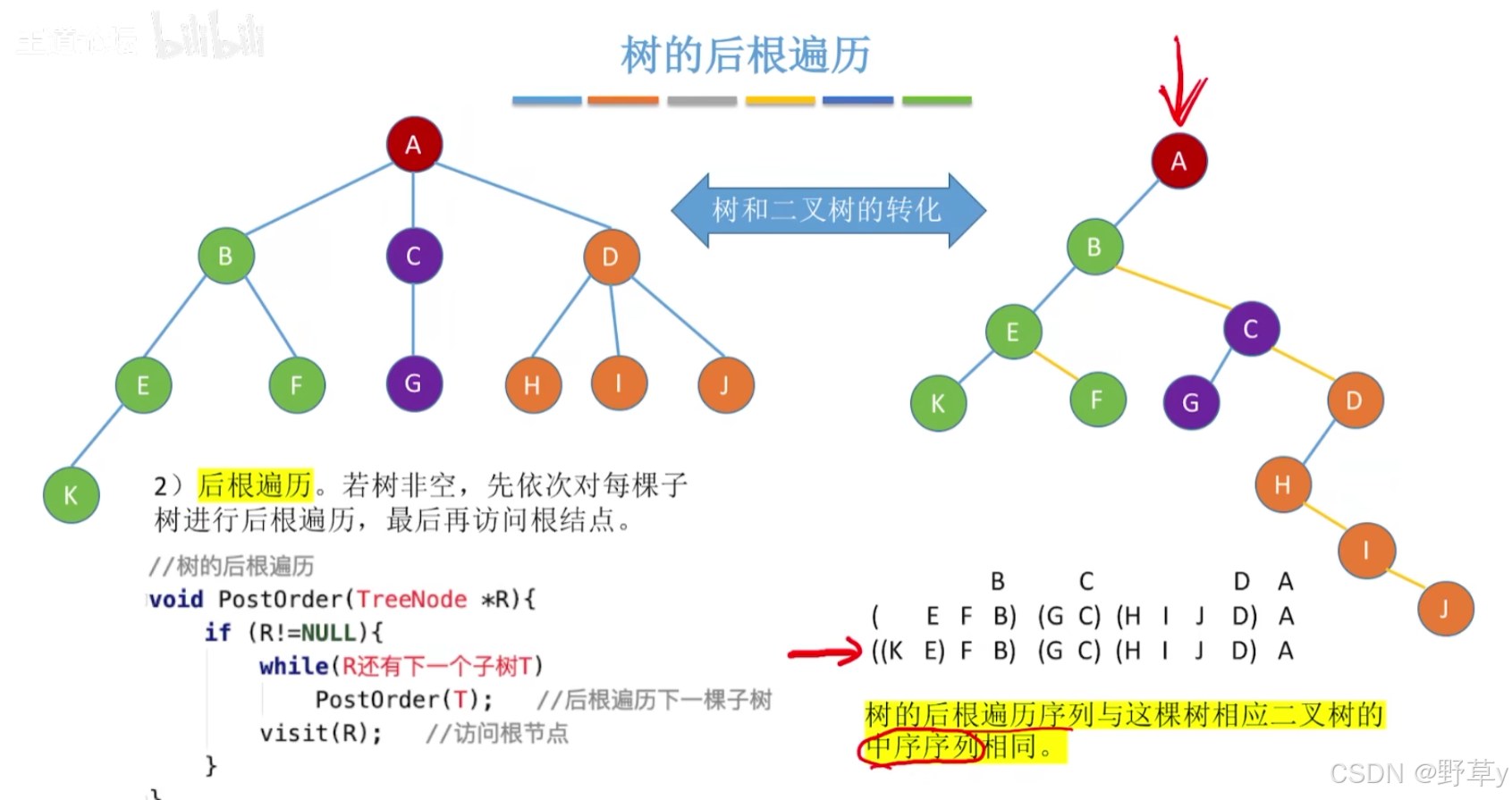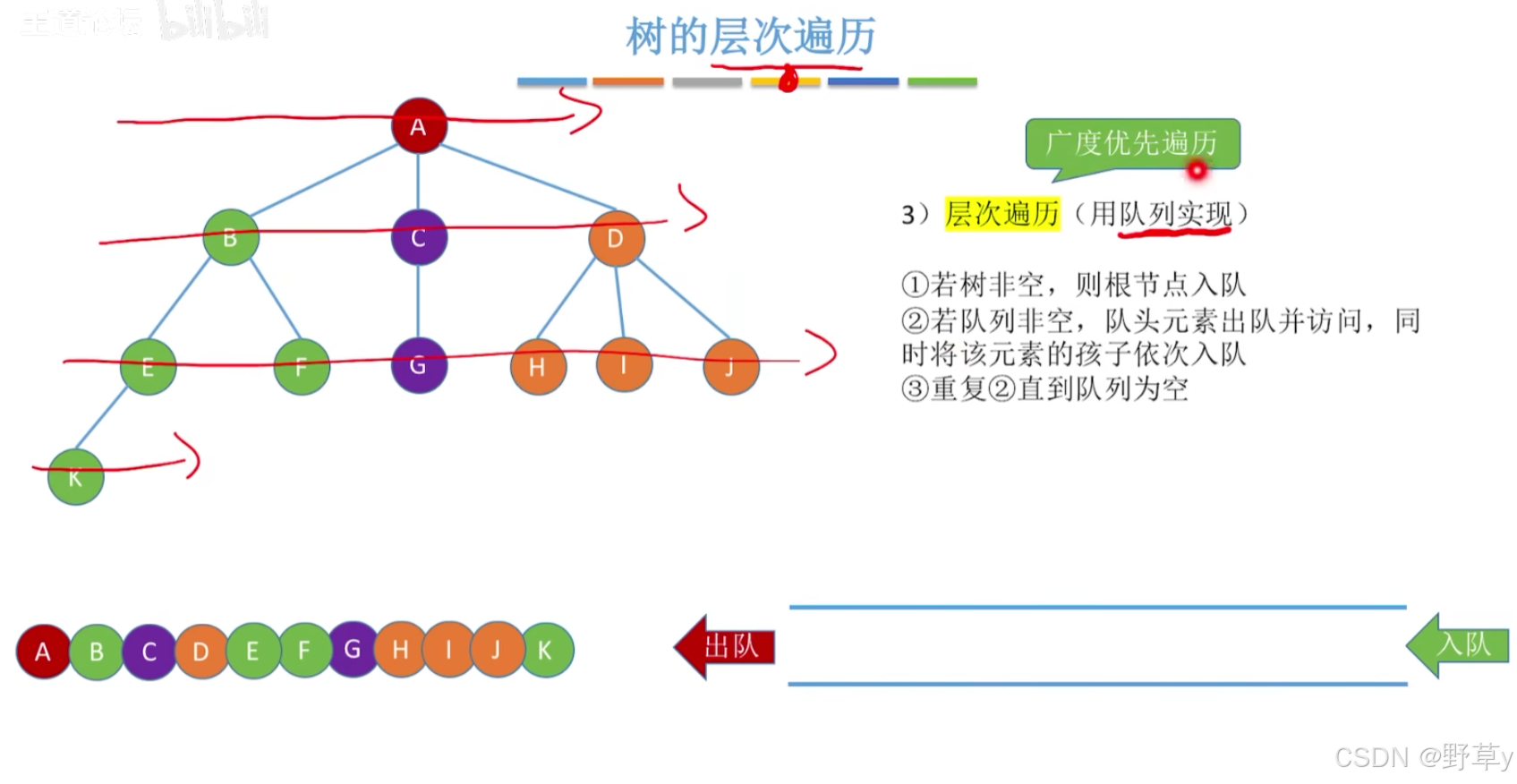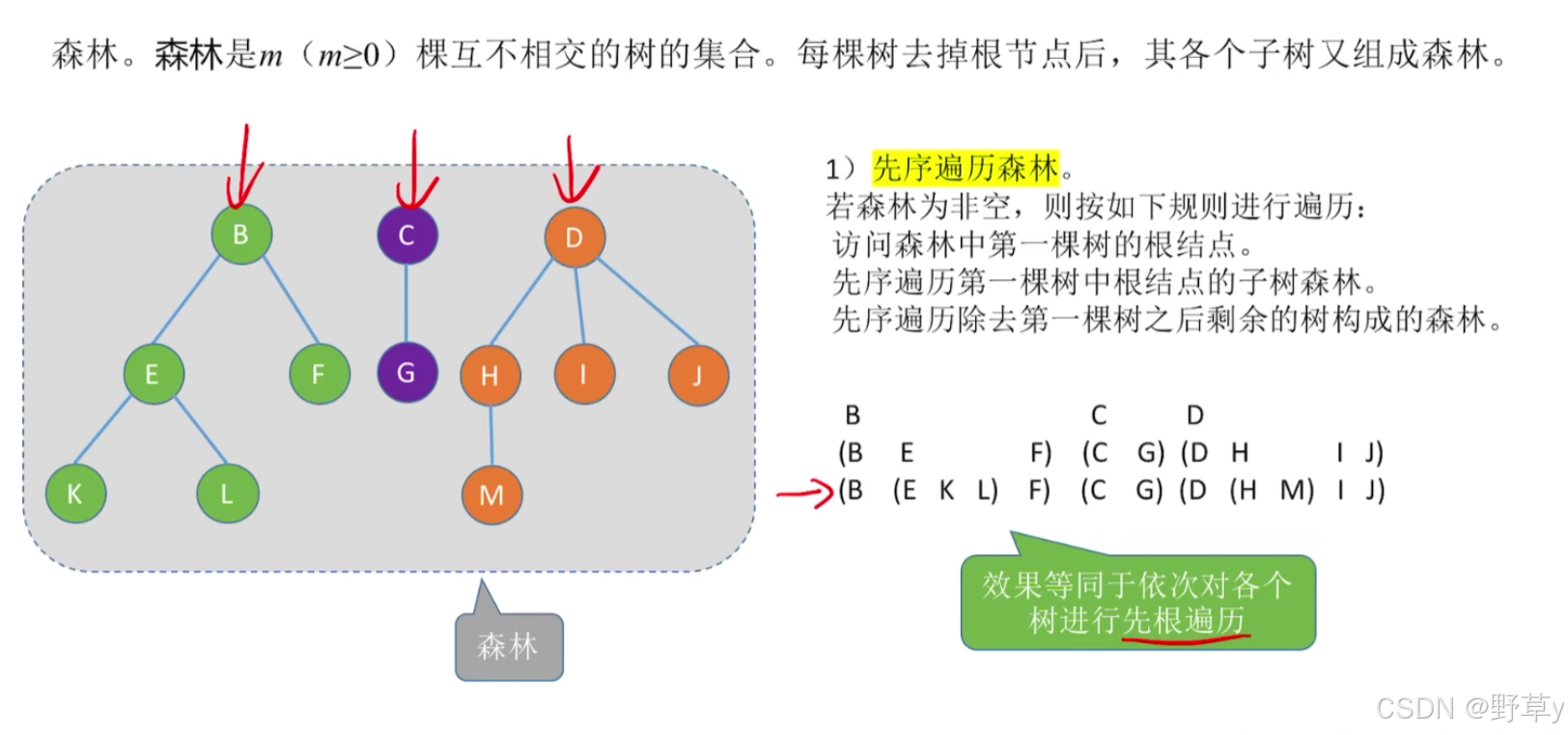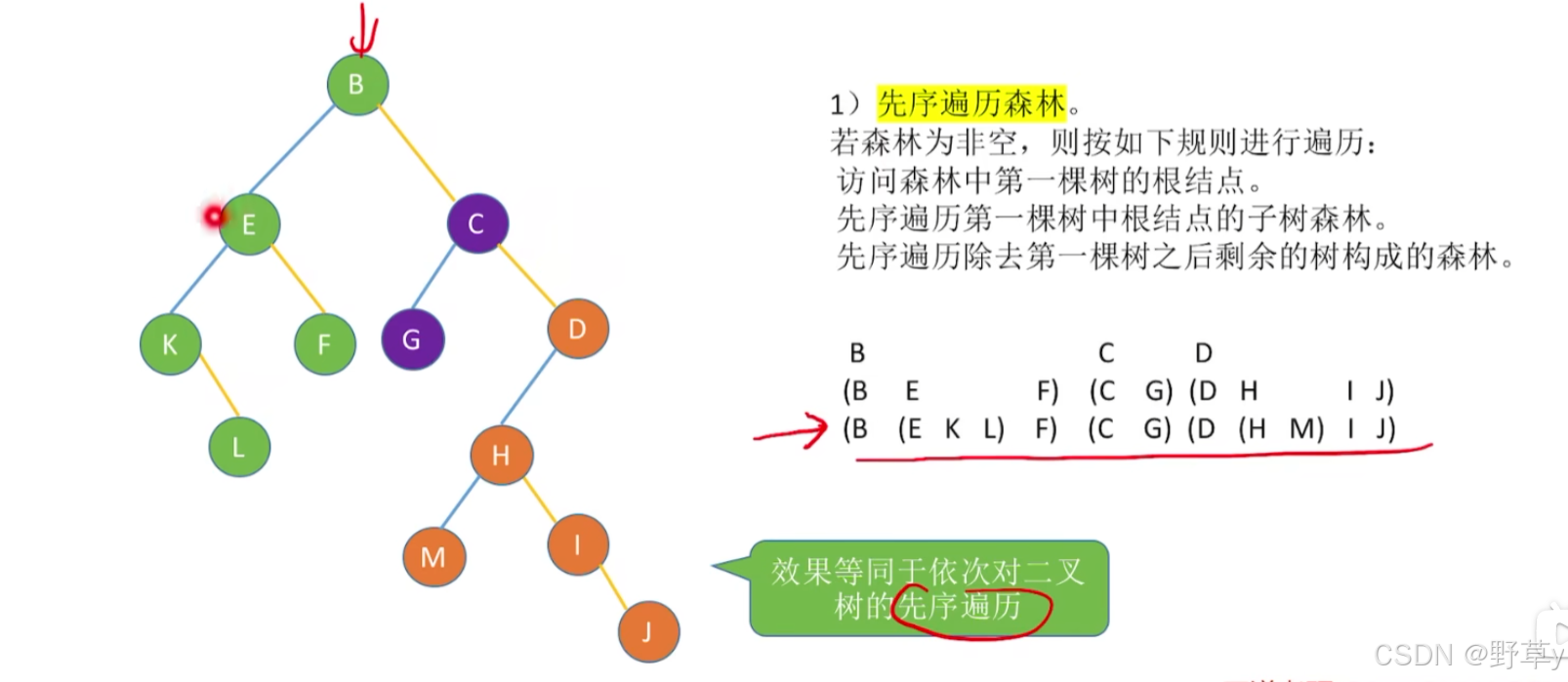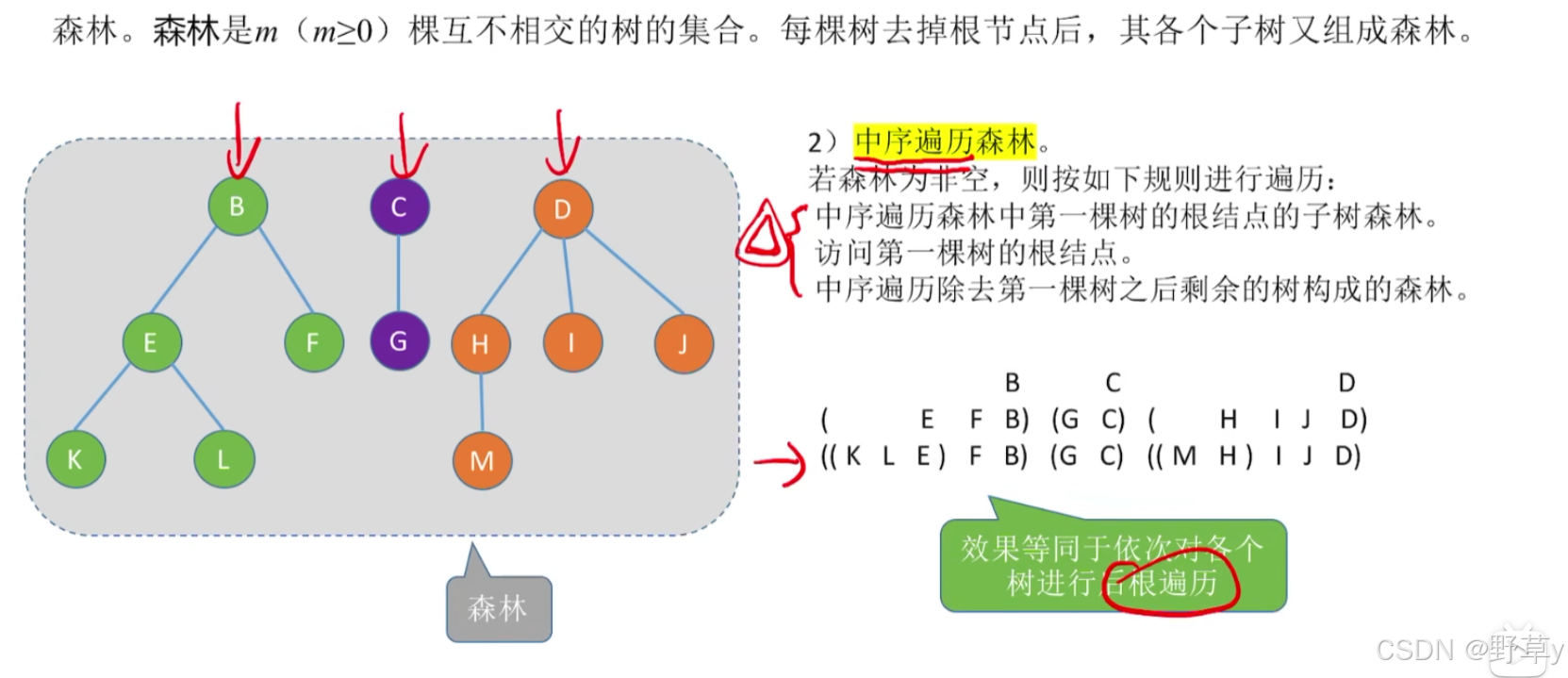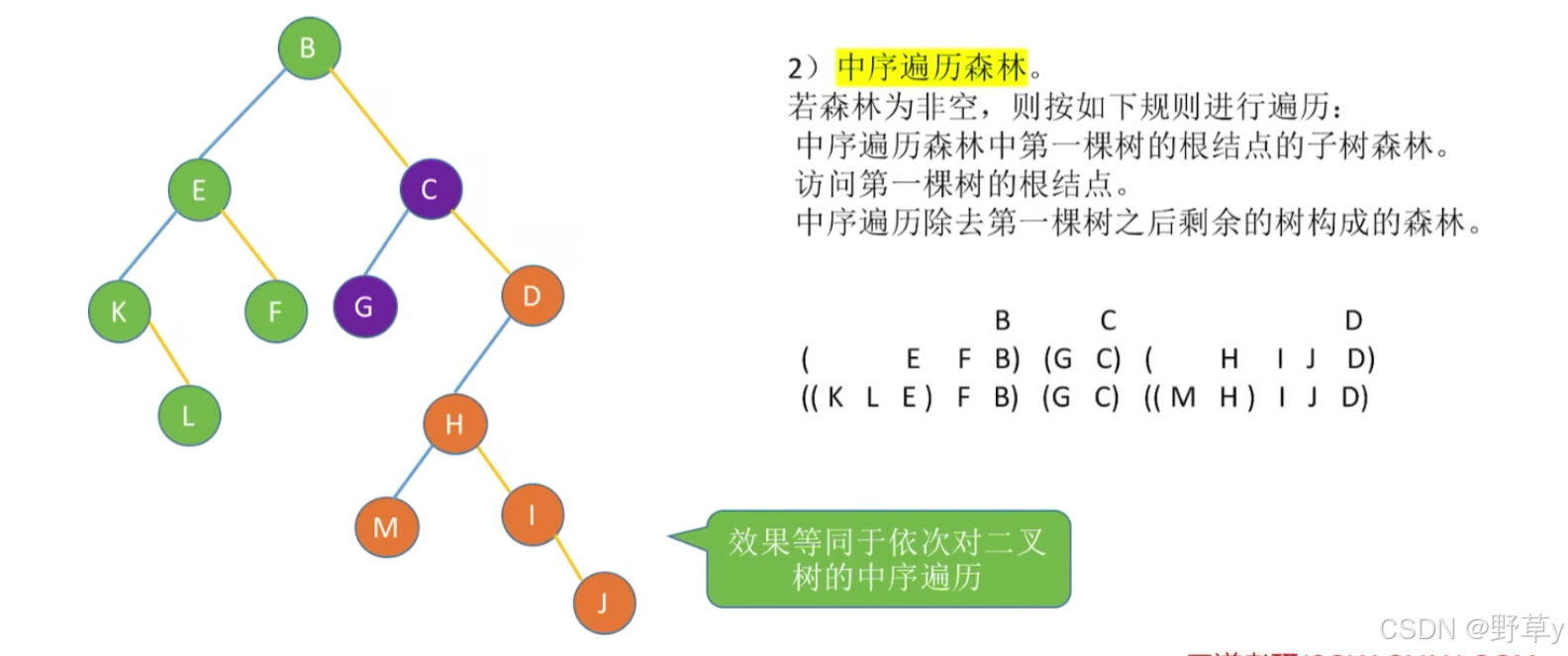树的先根遍历(深度优先遍历)
若树非空,先访问根结点,再依次对每棵子树进行先根遍历
树的先根遍历序列和这棵树相应二叉树的先序序列相同。
伪代码:
//树的先根遍历
void PreOrder(TreeNode* R) {
if (R != NULL) {
visit(R);//访问根结点
while(R还有下一个子树T)
PreOrder(T)//先根遍历下一棵子树
}
}实例:
#include <stdio.h>
// 定义树节点的结构体(兄弟兄弟表示法)
typedef struct CSNode {
int data; // 节点存储的数据
struct CSNode* firstchild; // 指向第一个子节点的指针
struct CSNode* nextsibling; // 指向右兄弟节点的指针
} CSNode, *CSTree;
// 创建一个新树节点
CSNode* createTreeNode(int value) {
CSNode* newNode = (CSNode*)malloc(sizeof(CSNode));
if (newNode == NULL) {
fprintf(stderr, "Memory allocation failed.\n");
exit(EXIT_FAILURE);
}
newNode->data = value;
newNode->firstchild = NULL;
newNode->nextsibling = NULL;
return newNode;
}
// 向树节点添加子节点
void addChild(CSTree parent, CSTree child) {
if (parent == NULL || child == NULL) {
return;
}
if (parent->firstchild == NULL) {
parent->firstchild = child;
} else {
CSTree current = parent->firstchild;
while (current->nextsibling != NULL) {
current = current->nextsibling;
}
current->nextsibling = child;
}
}
// 访问节点
void visit(CSNode* node) {
if (node != NULL) {
printf("%d ", node->data);
}
}
// 先根遍历
void PreOrder(CSTree R) {
if (R != NULL) {
visit(R); // 访问根节点
CSTree current = R->firstchild;
while (current != NULL) {
PreOrder(current); // 先根遍历子树
current = current->nextsibling; // 移动到下一个兄弟节点
}
}
}
// 释放树的内存
void freeTree(CSTree root) {
if (root == NULL) {
return;
}
CSTree current = root->firstchild;
while (current != NULL) {
CSTree temp = current;
current = current->nextsibling;
freeTree(temp);
}
free(root);
}
// 主函数示例
int main() {
// 创建树节点
CSTree root = createTreeNode(1);
CSTree child1 = createTreeNode(2);
CSTree child2 = createTreeNode(3);
CSTree child3 = createTreeNode(4);
CSTree child4 = createTreeNode(5);
CSTree child5 = createTreeNode(6);
// 构建树结构
addChild(root, child1);
addChild(root, child2);
addChild(child1, child3);
addChild(child1, child4);
addChild(child2, child5);
// 执行先根遍历
printf("Pre-order traversal of the tree is: ");
PreOrder(root);
printf("\n");
// 释放树占用的内存
freeTree(root);
return 0;
}
我们首先创建了一个树,然后通过 addChild 函数将子节点添加到其父节点。PreOrder 函数按照先根遍历的顺序访问每个节点。最后,我们通过 freeTree 函数释放了整个树所占用的内存。在主函数 main 中,我们构建了一个具体的树结构,并执行了先根遍历。
树的后根遍历 (深度优先遍历)
若树非空,先依次对每棵子树进行后根遍历,最后再访问根结点
树的后根遍历序列和这棵树相应二叉树的中序序列相同。
伪代码:
//树的后根遍历
void PostOrder(TreeNode* R) {
if (R != NULL) {
while (R还有下一个子树T)
PostOrder(T)//后根遍历下一棵子树
visit(R);//访问根结点
}
}实例:
#include <stdio.h>
// 定义树节点的结构体(兄弟兄弟表示法)
typedef struct CSNode {
int data; // 节点存储的数据
struct CSNode* firstchild; // 指向第一个子节点的指针
struct CSNode* nextsibling; // 指向右兄弟节点的指针
} CSNode, *CSTree;
// 创建一个新树节点
CSNode* createTreeNode(int value) {
CSNode* newNode = (CSNode*)malloc(sizeof(CSNode));
if (newNode == NULL) {
fprintf(stderr, "Memory allocation failed.\n");
exit(EXIT_FAILURE);
}
newNode->data = value;
newNode->firstchild = NULL;
newNode->nextsibling = NULL;
return newNode;
}
// 向树节点添加子节点
void addChild(CSTree parent, CSTree child) {
if (parent == NULL || child == NULL) {
return;
}
if (parent->firstchild == NULL) {
parent->firstchild = child;
} else {
CSTree current = parent->firstchild;
while (current->nextsibling != NULL) {
current = current->nextsibling;
}
current->nextsibling = child;
}
}
// 访问节点
void visit(CSNode* node) {
if (node != NULL) {
printf("%d ", node->data);
}
}
// 后根遍历
void PostOrder(CSTree R) {
if (R != NULL) {
CSTree current = R->firstchild;
while (current != NULL) {
PostOrder(current); // 后根遍历子树
current = current->nextsibling; // 移动到下一个兄弟节点
}
visit(R); // 访问根节点
}
}
// 释放树的内存
void freeTree(CSTree root) {
if (root == NULL) {
return;
}
CSTree current = root->firstchild;
while (current != NULL) {
CSTree temp = current;
current = current->nextsibling;
freeTree(temp);
}
free(root);
}
// 主函数示例
int main() {
// 创建树节点
CSTree root = createTreeNode(1);
CSTree child1 = createTreeNode(2);
CSTree child2 = createTreeNode(3);
CSTree child3 = createTreeNode(4);
CSTree child4 = createTreeNode(5);
CSTree child5 = createTreeNode(6);
// 构建树结构
addChild(root, child1);
addChild(root, child2);
addChild(child1, child3);
addChild(child1, child4);
addChild(child2, child5);
// 执行后根遍历
printf("Post-order traversal of the tree is: ");
PostOrder(root);
printf("\n");
// 释放树占用的内存
freeTree(root);
return 0;
}
我们首先创建了一个树,然后通过 addChild 函数将子节点添加到其父节点。PostOrder 函数按照后根遍历的顺序访问每个节点。首先递归地遍历所有子树,然后访问根节点。最后,我们通过 freeTree 函数释放了整个树所占用的内存。在主函数 main 中,我们构建了一个具体的树结构,并执行了后根遍历。
树的层次遍历 (广度优先遍历)
用队列实现:
- 若树非空,则根节点入队
- 若队列非空,队头元素出队并访问,同时将该元素的孩子依次入队
- 重复2直到队列为空
伪代码:
// 树的层次遍历
void LevelOrder(TreeNode* root) {
if (root == NULL) {
return;
}
// 创建一个队列,用于存储待访问的节点
Queue queue;
initializeQueue(&queue);
// 将根节点入队
enqueue(queue, root);
// 当队列不为空时,继续遍历
while (!isEmpty(queue)) {
// 出队一个节点
TreeNode* current = dequeue(queue);
// 访问当前节点
visit(current);
// 获取当前节点的所有子节点
TreeNode* child = current->firstchild;
// 遍历当前节点的所有子节点
while (child != NULL) {
enqueue(queue, child);
child = child->nextsibling;
}
}
}
// 辅助函数:初始化队列
void initializeQueue(Queue* queue) {
queue->front = NULL;
queue->rear = NULL;
}
// 辅助函数:队列是否为空
bool isEmpty(Queue queue) {
return queue.front == NULL;
}
// 辅助函数:将节点入队
void enqueue(Queue* queue, TreeNode* node) {
QueueNode* newNode = (QueueNode*)malloc(sizeof(QueueNode));
if (newNode == NULL) {
// 处理内存分配失败的情况
}
newNode->node = node;
newNode->next = NULL;
if (queue->rear == NULL) {
queue->front = newNode;
} else {
queue->rear->next = newNode;
}
queue->rear = newNode;
}
// 辅助函数:从队列中出队一个节点
TreeNode* dequeue(Queue* queue) {
if (isEmpty(*queue)) {
return NULL;
}
TreeNode* frontNode = queue->front->node;
QueueNode* temp = queue->front;
queue->front = queue->front->next;
if (queue->front == NULL) {
queue->rear = NULL;
}
free(temp);
return frontNode;
}
代码实例:
#include <stdio.h>
#include <stdlib.h>
#include <stdbool.h>
// 定义树节点的结构体(兄弟兄弟表示法)
typedef struct CSNode {
int data; // 节点存储的数据
struct CSNode* firstchild; // 指向第一个子节点的指针
struct CSNode* nextsibling; // 指向右兄弟节点的指针
} CSNode, *CSTree;
// 创建一个新树节点
CSNode* createTreeNode(int value) {
CSNode* newNode = (CSNode*)malloc(sizeof(CSNode));
if (newNode == NULL) {
fprintf(stderr, "Memory allocation failed.\n");
exit(EXIT_FAILURE);
}
newNode->data = value;
newNode->firstchild = NULL;
newNode->nextsibling = NULL;
return newNode;
}
// 向树节点添加子节点
void addChild(CSTree parent, CSTree child) {
if (parent == NULL || child == NULL) {
return;
}
if (parent->firstchild == NULL) {
parent->firstchild = child;
} else {
CSTree current = parent->firstchild;
while (current->nextsibling != NULL) {
current = current->nextsibling;
}
current->nextsibling = child;
}
}
// 访问节点
void visit(CSNode* node) {
if (node != NULL) {
printf("%d ", node->data);
}
}
// 层次遍历
void LevelOrder(CSTree root) {
if (root == NULL) {
return;
}
CSTree current = root;
bool isRoot = true;
while (current != NULL) {
if (isRoot) {
visit(current); // 访问根节点
isRoot = false;
}
CSTree temp = current->firstchild;
while (temp != NULL) {
visit(temp); // 访问当前节点的所有子节点
temp = temp->nextsibling;
}
current = current->nextsibling; // 移动到下一个兄弟节点
}
}
// 释放树的内存
void freeTree(CSTree root) {
if (root == NULL) {
return;
}
CSTree current = root->firstchild;
while (current != NULL) {
CSTree temp = current;
current = current->nextsibling;
freeTree(temp);
}
free(root);
}
// 主函数示例
int main() {
// 创建树节点
CSTree root = createTreeNode(1);
CSTree child1 = createTreeNode(2);
CSTree child2 = createTreeNode(3);
CSTree child3 = createTreeNode(4);
CSTree child4 = createTreeNode(5);
CSTree child5 = createTreeNode(6);
// 构建树结构
addChild(root, child1);
addChild(root, child2);
addChild(child1, child3);
addChild(child1, child4);
addChild(child2, child5);
// 执行层次遍历
printf("Level-order traversal of the tree is: ");
LevelOrder(root);
printf("\n");
// 释放树占用的内存
freeTree(root);
return 0;
}
我们首先创建了一个树,然后通过 addChild 函数将子节点添加到其父节点。LevelOrder 函数按照层次遍历的顺序访问每个节点。首先将根节点入队,然后在循环中不断从队列中出队节点并访问它,然后将它的所有子节点入队。当队列为空时,遍历结束。最后,我们通过 freeTree 函数释放了整个树所占用的内存。在主函数 main 中,我们构建了一个具体的树结构,并执行了层次遍历。
森林。森林是m(m>=0)棵互不相交的树的集合。每棵树去掉根节点后,其各个子树又组成森林。
森林的先序遍历
若森林非空,则按如下规则进行遍历:
- 访问森林中第一棵树的根结点
- 先序遍历第一棵树中根结点的子树森林
- 先序遍历除去第一棵树之后剩余的树构成的森林
森林的先序遍历等于依次对各个树进行先根遍历
方法二:将森林先转换成二叉树进行先序遍历
森林的中序遍历
若森林非空,则按如下规则进行遍历:
- 中序遍历第一棵树中根结点的子树森林
- 访问森林中第一棵树的根结点
- 中序遍历除去第一棵树之后剩余的树构成的森林
森林的中序遍历等于依次对各个树进行后根遍历
方法二:将森林先转换成二叉树进行中序遍历
总结:

